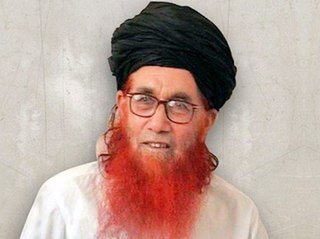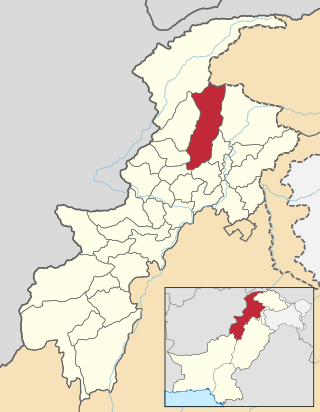
Shangla District is a district in Malakand Division of Khyber Pakhtunkhwa, Pakistan. The district's headquarter is located at Alpuri, while the largest city and commercial center is Besham. The district was established in 1995, having previously been a subdivision of Swat District. The total area of the district is 1,586 square kilometers. Shangla comprises three subdivisions, Alpuri, Puran and Besham tehsils.
The Pakistan Rangers are a pair of paramilitary federal law enforcement corps' in Pakistan. The two corps are the Punjab Rangers and the Sindh Rangers. There is also a third corps headquarters in Islamabad but is only for units transferred from the other corps for duties in the federal capital. They are both part of the Civil Armed Forces. The corps' operate administratively under the Pakistan Army but under separate command structures and wear distinctly different uniforms. However, they are usually commanded by officers on secondment from the Pakistan Army. Their primary purpose is to secure and defend the approximately 2,200 km (1,400 mi) long border with neighbouring India. They are also often involved in major internal and external security operations with the regular Pakistani military and provide assistance to municipal and provincial police forces to maintain law and order against crime, terrorism and unrest. In addition, the Punjab Rangers, together with the Indian Border Security Force, participate in an elaborate flag lowering ceremony at the Wagah−Attari border crossing east of Lahore.
Alpuri is the capital of Shangla District in the Khyber-Pakhtunkhwa province of Pakistan. It is located at 34°54′00″N72°39′00″E and has an average elevation of 1587 meters. The place has a government degree college and District headquarters hospital.

The insurgency in Khyber Pakhtunkhwa, also known as the War in North-West Pakistan or Pakistan's war on terror, is an ongoing armed conflict involving Pakistan and Islamist militant groups such as the Tehrik-i-Taliban Pakistan (TTP), Jundallah, Lashkar-e-Islam (LeI), TNSM, al-Qaeda, and their Central Asian allies such as the ISIL–Khorasan (ISIL), Islamic Movement of Uzbekistan, East Turkistan Movement, Emirate of Caucasus, and elements of organized crime. Formerly a war, it is now a low-level insurgency as of 2017.
Fazal Hayat, more commonly known by his pseudonym Mullah Fazlullah, was an Islamist militant who was the leader of the Tehreek-e-Nafaz-e-Shariat-e-Mohammadi, and was the leader of the Tehreek-e-Taliban Pakistan in Swat Valley. On 7 November 2013, he became the emir of the Tehrik-i-Taliban Pakistan, and presided over the descent of the group into factions who are often at war with each other. Fazlullah was designated by the Al-Qaida and Taliban Sanctions Committee of the Security Council in 2015, and was added to the U.S. State Department's Rewards for Justice wanted list on 7 March 2018. Fazlullah was killed in a U.S. drone strike in Kunar, Afghanistan on 14 June 2018.

The Helmand province campaign was a series of military operations conducted by the International Security Assistance Force (ISAF) forces against Taliban insurgents and other local groups in the Helmand Province of Afghanistan. Their objective was to control a province that was known to be a Taliban stronghold, and a center of opium production. None of the ISAF's intended strategic and political objectives were achieved in the long term.

The Pakistani Taliban, formally called the Tehreek-e-Taliban-e-Pakistan, is an umbrella organization of various Islamist armed militant groups operating along the Afghan–Pakistani border. Formed in 2007 by Baitullah Mehsud, its current leader is Noor Wali Mehsud, who has publicly pledged allegiance to the Afghan Taliban. The Pakistani Taliban share a common ideology with the Afghan Taliban and have assisted them in the 2001–2021 war, but the two groups have separate operation and command structures.
Kabalgram or Kabal Gram is a village with the largest population in Martung Tehsil of Shangla District, Khyber Pakhtunkhwa province Pakistan. It is situated on the extreme right bank of River Indus and is south-east to Kuzkalai, the central village of Martung. River Indus is the boundary of Shangla with Tor-Ghar District of Hazara division.

Muhammed Afzal Khan Lala also known as Afzal Khan Lala was a Pashtun nationalist, former Pakistani provincial and Federal minister from the Swat valley in the North-West Frontier Province.

Tehreek-e-Nafaz-e-Shariat-e-Mohammadi is an Islamic extremist militant group. The group swore an oath of loyalty to Pakistani Taliban and become the part of it in 2007 aftermath the siege of Lal Masjid. The group's stated objective is to enforce Sharia law in Pakistan.

Sufi Muhammad bin Alhazrat Hassan was a Pakistani Sunni Islamist cleric and militant, and the founder of Tehreek-e-Nafaz-e-Shariat-e-Mohammadi (TNSM), a militant group vying for implementation of Sharia in Pakistan. It operated mainly in the Dir, Swat, and Malakand districts of Khyber-Pakhtunkhwa.
The Nizam-e-Adl Regulation was a controversial act, passed on April 13, 2009 by Government of Pakistan that formally established Sharia law in the Malakand division. PPP-led central government passed the bill after a coalition partner ANP government in Khyber Pakhtunkhwa negotiated the peace deal with outlawed Tehreek-e-Nafaz-e-Shariat-e-Mohammadi.

Operation Black Thunderstorm was a military operation that commenced on April 26, 2009, conducted by the Pakistan Army, with the aim of retaking Buner, Lower Dir, Swat and Shangla districts from the Tehrik-i-Taliban Pakistan after the militants took control of them since the start of the year.

The following addresses the events in Northern Afghanistan between April 2009 and 2014. While this part of the country had long been relatively peaceful compared to the all-out war zones of the south and east, tensions would flare up again in 2008 when the German soldiers deployed to the area came under attack more often, leading to the deaths of the several soldiers. Previously hindered by national caveats, the deteroriating security situation prompted the German-led Regional Command North to launch a series of operations to take on the rising insurgency. Concerted operations began after an insurgent attack on PRT Kunduz within minutes of German Chancellor Angela Merkel's departure from a visit. Within two years, the German presence would be doubled and additional reinforcements from the American ISAF contingent were called in, including heavy German armoured vehicles and US aviation assets, allowing for a more aggressive approach towards the insurgency.

The Second Battle of Swat also known as Operation Rah-e-Rast, began in May 2009 and involved the Pakistan Army and Tehrik-i-Taliban Pakistan militants in a fight for control of the Swat district of Pakistan. The first Battle of Swat had ended with a peace agreement, that the government had signed with the Tehrik-i-Taliban Pakistan in February 2009. However, by late April 2009 government troops and the Tehrik-i-Taliban Pakistan began to clash once again, and in May the government launched a military offensive code-named Operation Black Thunderstorm throughout the Swat district and elsewhere to oppose the Tehrik-i-Taliban Pakistan.

The Operation Rah-e-Nijat was a strategic offensive military operation by the unified command of Pakistan Armed Forces against the Tehrik-i-Taliban Pakistan (TTP) and their extremist allies in the South Waziristan area of the Federally Administered Tribal Areas that began on June 19, 2009; a major ground-air offensive was subsequently launched on October 17. It became the integral part of the war in Western fronts which led to the encirclement and destruction of Taliban forces in the region, although the Taliban leadership escaped to lawless areas of neighboring Afghanistan.

The Operation Sirat-e-Mustaqeem , was a Pakistan Army operation in Bara Tehsil of Khyber Agency, Federally Administered Tribal Areas. The operation was commenced on June 28, 2008, and was halted by the Army on July 9, 2008, after liberating Bara Tehsil from the terrorist. On July 9, 2008 another operation, codenamed Zarbe-Kaleem, was launched in Hangu district.
In 2007, 34 terrorist attacks and clashes, including suicide attacks, killings, and assassinations, resulted in 134 casualties and 245 injuries, according to the PIPS security report. The report states that Pakistan faced 20 suicide attacks during 2007, which killed at least 111, besides injuring another 234 people. The PIPS report shows visible increase in suicide attacks after the siege of Lal Masjid.
Maulana Shah Dauran was an Islamist militant from Swat, Pakistan. He was a deputy of Fazlullah, the chief of the Pakistani Taliban in Swat. He was one of the most wanted militants and the closest aide of Swat Taliban chief Maulana Fazlullah. He was known for his hawkish views against the opponents. The government of Khyber Pakhtunkhwa announced a 10 million rupees bounty on Dauran.
On October 11, 2009, a suicide bomber threw himself in front of a military truck as it went through a busy market in Alpuri town, Shangla district, Pakistan. Shangla is a district next to Swat valley that was recently the target of a military operation against the Taliban.










